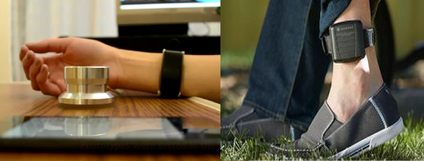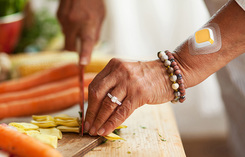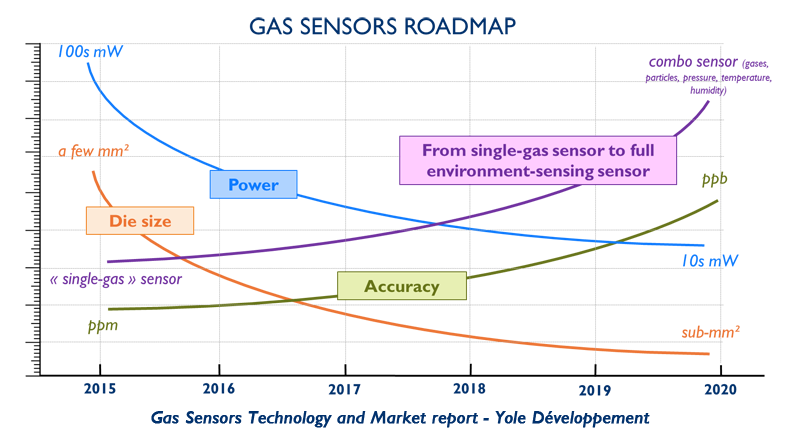


Human skin is a super-highway of many small molecules reflecting our health and wellbeing. Various devices capable of "seeing" through our skin were announced in the past several years. Some of them - like AIRO watch claiming to detect metabolites in your bloodstream as they are released during and after meals - turned out to be vaporware. The jury is still out on many others like HealbeGobe. And the remaining ones are still in prototyping stages.

Halo Wearables will launch their non-invasive hydration monitoring wearable in early 2016. It is tailored specifically for elite athletes. Halo's optical sensors track sodium and potassium levels in the user's blood.
Researchers from the University of California, Berkeley, Stanford and Lawrence Berkeley National Laboratory have also developed a wearable sensor that can monitor sodium, potassium and lactate levels in sweat. A paper with their findings was published in Nature earlier this year.
Startup Xsensio, accepted this year in Mass Challenge accelerator, works on “intelligent stamps” the size of a credit card (Lab-on-Skin wearables) including a unique low-power sensor for sweat analysis.
ECHO smart patch from Kenzen aims to "silently follow your health, and notify you only when it's most important". It analyzes sodium and potassium in sweat to monitor hydration, lactic acid and glucose analysis energy expenditure.

A team from Seoul National University, University of Texas and a Massachusetts-based company MC10 are developing a flexible patch that senses glucose in people with diabetes and administers drugs, all in a single device.
And there may be easier ways to display all the information collected from various sensors - perhaps even directly on the body - as the team from the University of Tokyo demonstrated with device measuring oxygen saturation levels in blood.

Andreoni G, Standoli CE, & Perego P (2016). Defining Requirements and Related Methods for Designing Sensorized Garments. Sensors (Basel, Switzerland), 16 (6) PMID: 27240361
Gao W, Emaminejad S, Nyein HY, Challa S, Chen K, Peck A, Fahad HM, Ota H, Shiraki H, Kiriya D, Lien DH, Brooks GA, Davis RW, & Javey A (2016). Fully integrated wearable sensor arrays for multiplexed in situ perspiration analysis. Nature, 529 (7587), 509-14 PMID: 26819044
Imani S, Bandodkar AJ, Mohan AM, Kumar R, Yu S, Wang J, & Mercier PP (2016). A wearable chemical-electrophysiological hybrid biosensing system for real-time health and fitness monitoring. Nature communications, 7 PMID: 27212140
Lee H, Choi TK, Lee YB, Cho HR, Ghaffari R, Wang L, Choi HJ, Chung TD, Lu N, Hyeon T, Choi SH, & Kim DH (2016). A graphene-based electrochemical device with thermoresponsive microneedles for diabetes monitoring and therapy. Nature nanotechnology, 11 (6), 566-72 PMID: 26999482
Panneer Selvam A, Muthukumar S, Kamakoti V, & Prasad S (2016). A wearable biochemical sensor for monitoring alcohol consumption lifestyle through Ethyl glucuronide (EtG) detection in human sweat. Scientific reports, 6 PMID: 26996103
Yokota T, Zalar P, Kaltenbrunner M, Jinno H, Matsuhisa N, Kitanosako H, Tachibana Y, Yukita W, Koizumi M, & Someya T (2016). Ultraflexible organic photonic skin. Science advances, 2 (4) PMID: 27152354
Coyle S, Lau KT, Moyna N, O'Gorman D, Diamond D, Di Francesco F, Costanzo D, Salvo P, Trivella MG, De Rossi DE, Taccini N, Paradiso R, Porchet JA, Ridolfi A, Luprano J, Chuzel C, Lanier T, Revol-Cavalier F, Schoumacker S, Mourier V, Chartier I, Convert R, De-Moncuit H, Bini C. BIOTEX--biosensing textiles for personalised healthcare management. IEEE Trans Inf Technol Biomed. 2010 Mar;14(2):364-70. doi: 10.1109/TITB.2009.2038484. Epub 2010 Jan 8.
 RSS Feed
RSS Feed
